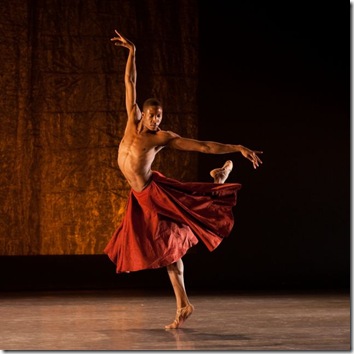Alonzo King Lines Ballet: Resin and Scheherazade. A woundrous state of human bonding that calls up the origins of the human species.
Photo: Bruce Barrett
Watching these two performances by the Alonzo King Lines Ballet I felt myself being transported into an archaic world configured by the power of heat, and light, and air and earth, yet drawing our gaze into a world of highly ritualized human movement that has clear links to the present. The two performances, Resin and Scheherazade were very different. Resin had no narrative. It was abstract and yet the music, taken from Sephardi music, Israeli teaching of an alphabet lesson, songs in Yiddish , in Ladino, in Arabic, create a soundscape of Mediterranean non-western tones, produced by sad wailing voices and instruments of multiple origins that prepare us for the exploding of our classical notions of balletic movement. Highly formalistic, this company is bathed in a rethinking of the human body subjected to a rigorous ballet training completely transformed by a new sense of bodily stance and new
relationships with the world. The movements are not sharp or angular, they flow, and the body becomes liquid. The figures seem to entwine themselves around each other, like snakes, like living creatures drawn to each other or to various parts of their own bodies. The duos and quartets and groups of dancers ooze gracefully among, around, and through each other. And as the classical forms seem to melt away, individuals and groups of 2 or 3 or four come to the foreground. One can recognize fleeting gestures related to Hassidic prayers, or religious trances, or traditional movements from founding societies of the Mediterranean that send the bodies whirling across the stage, or covering their eyes. The singing and chanting punctured the unstable landscape of dancers who twist the regularity of the balletic line. The magical use of light heightened the living pods that drifted down to the stage, producing human forms, sculpted by the glow of light and earthy colours. Freed from the rigidity of the classical form, I felt we were watching some wondrous state of human bonding that called up the origins of the human species.
Scheherazade, on the other had is based on the narrative of the Persian princess who must keep telling stories to the Sultan for 1 000 and one nights so he will not put her to death. The Ballet Russe’s 1910 production of their signature work, performed to Rimsky- Korsakov’s, music, first came to mind, since I had never seen The Alonzo King Lines ballet. It is clear that their version has nothing to do with the Russian production. Here, the composer’s music was completely transformed by tabla master Fakir Husain incorporating Persian as well as western instruments, so we barely recognize some of the famous themes that announce the movements of the original. As for the dancers, we recognize Scheherazade and the Sultan Shahryar, we recognize the handsome golden slave, the Chief Eunuch, the concubines, we see precisely choreographed orgies that unfold with the male slaves and the women in the harem but the feeling and the way the bodies express themselves physically is foregrounded, much more than the story. What struck me to a great extent and what brought this tale closer to Resin were the delicate costume designs by Colleen Queen and Robert Rosenwasser as well as Rosenwasser’s scenography and the exquisite work by lighting designer Axel Morgenthaler. This Scheherazade does not unfold in a sumptuously decorated oriental palace that resembles the esthetics of Bakst’s drawings, but in a place that suggests a huge sand cave somewhere buried in the desert. The backdrop appeared like a huge cliff carved out of sheer red rock almost like Petra, the famous Jordanian site of the 2000 year old Natabean tomb, the site of a departed people that suggests an archaic world. And then, the stage world freezes, the moment Scheherazade begins weaving the magic of her words.. Wafts of smoky substance transform the panels into greyish night shapes that engulph them all. The lighting becomes a dark shimmering blue that changes the texture of the great wall. The space is transported into the realm of invisible creatures brought to life by her story-telling. . Thus she enchants the Sultan. Liquid movement, flowing lines and heightened sensuality between the men and the women, or between fluctuating genders produced creatures who appeared to emerge out of a faraway past and yet, the mixed sources of their dancing was perfectly contemporary. A paradox that defines this beautiful and deeply moving example of bodies transposed into post ethnic dance.
When is Alonzo King Lines Ballet coming back to the NAC? It played May 4rth in Southam Hall of the NAC
